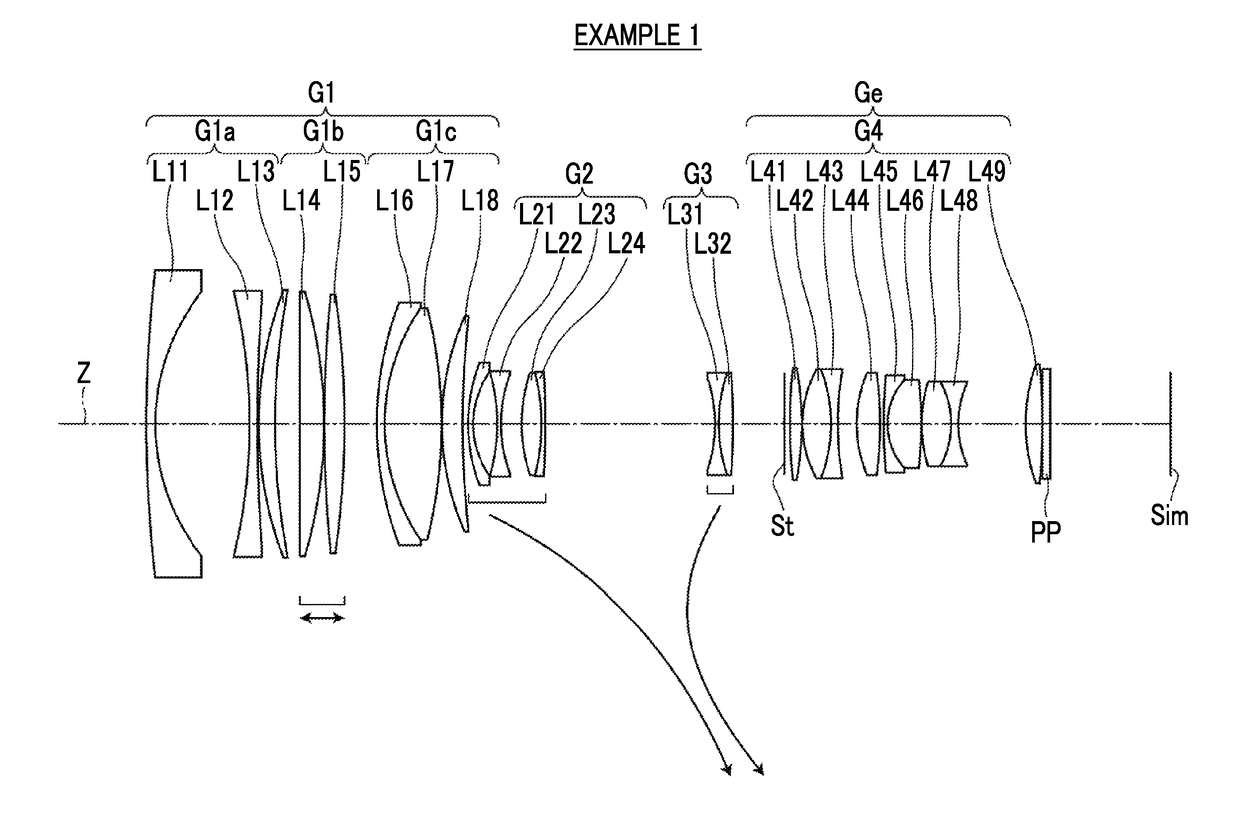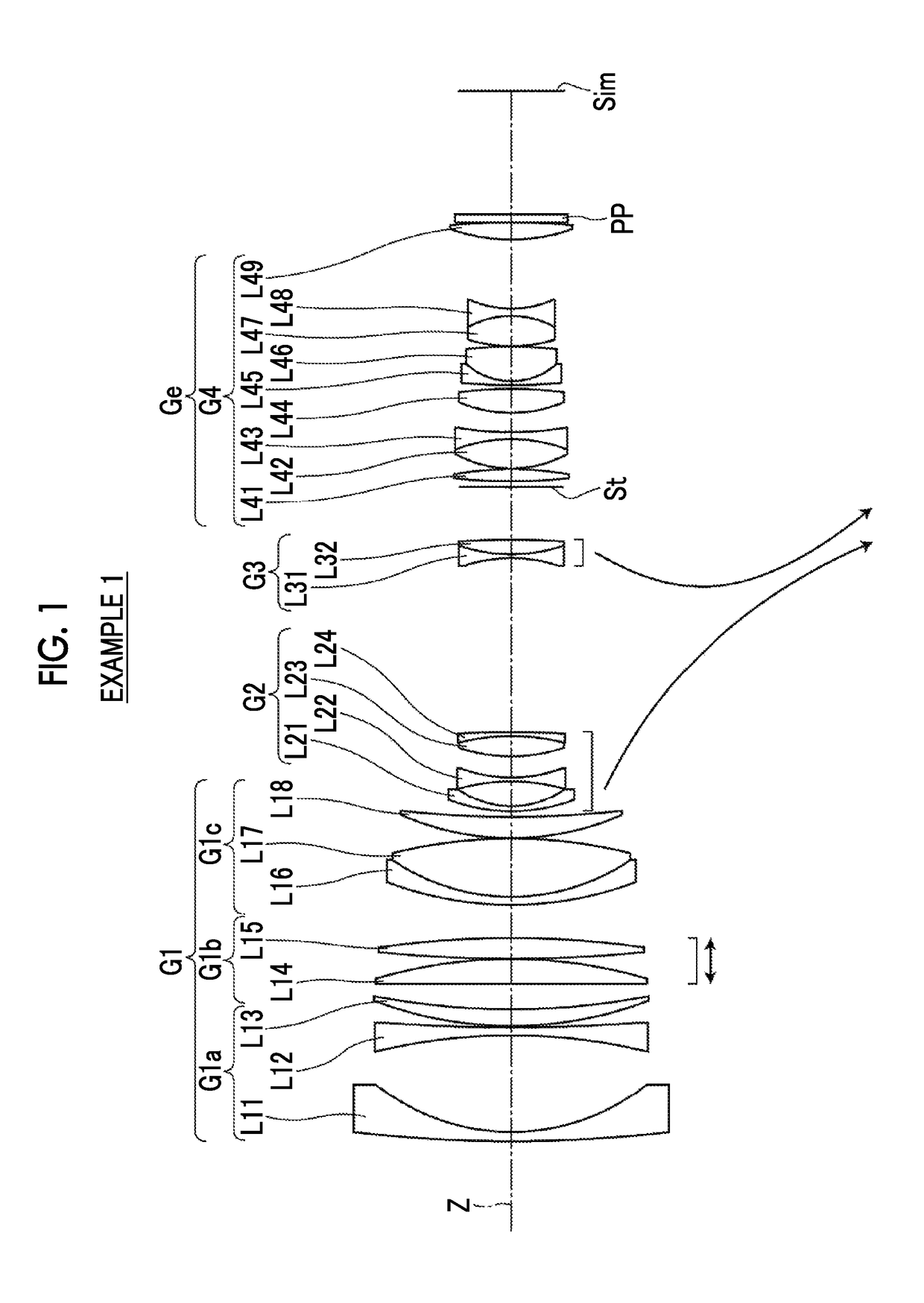Zoom lens and imaging apparatus
a zoom lens and imaging apparatus technology, applied in the field of zoom lenses, can solve the problems of inability to achieve the reduction of size, increase in the size of the first lens group, and large number of lenses of the first lens group, and achieve the effects of high optical performance, small size, and high zoom ratio
- Summary
- Abstract
- Description
- Claims
- Application Information
AI Technical Summary
Benefits of technology
Problems solved by technology
Method used
Image
Examples
example 1
[0089]A lens configuration of a zoom lens of Example 1 is shown in FIGS. 1 and 2, and an illustration method thereof is as described above. Therefore, repeated description is partially omitted herein. The zoom lens of Example 1 consists of, in order from the object side, a first lens group G1, a second lens group G2, a third lens group G3, an aperture stop St, and a fourth lens group G4. In these four lens groups, the distances in the direction of the optical axis between groups adjacent to each other change during zooming. Both the second lens group G2 and the third lens group G3 are movable lens groups having negative refractive powers. The first lens group G1 consists of, in order from the object side, a first lens group front group G1a that consists of three lenses and has a negative refractive power, a first lens group intermediate group G1b that consists of two lenses and has a positive refractive power, and a first lens group rear group G1c that consists of three lenses and h...
example 2
[0101]FIG. 4 is a cross-sectional view of a zoom lens of Example 2. The zoom lens of Example 2 consists of, in order from the object side, a first lens group G1, a second lens group G2, a third lens group G3, an aperture stop St, and a fourth lens group G4. The first lens group G1 consists of, in order from the object side, a first lens group front group G1a consisting of three lenses, a first lens group intermediate group G1b consisting of two lenses, and a first lens group rear group G1c consisting of three lenses. The present example is the same as Example 1 in terms of the signs of refractive powers of the lens groups, the lens groups moving during zooming, and the lens groups moving during focusing.
[0102]Table 4 shows basic lens data of the zoom lens of Example 2, Table 5 shows values of specification and variable surface distances, Table 6 shows aspheric coefficients, and FIG. 9 shows aberration diagrams in a state where the object at infinity is in focus.
TABLE 4Example 2SiRiD...
example 3
[0103]FIG. 5 is a cross-sectional view of a zoom lens of Example 3. The zoom lens of Example 3 consists of, in order from the object side, a first lens group G1, a second lens group G2, a third lens group G3, a fourth lens group G4, an aperture stop St, and a fifth lens group G5. In these five lens groups, the distances in the direction of the optical axis between groups adjacent to each other change during zooming. The second lens group G2 has a positive refractive power, the third lens group G3 has a negative refractive power, and the fourth lens group G4 has a negative refractive power. The three lens groups including the second to fourth lens groups G2 to G4 are respectively movable lens groups. The first lens group G1 consists of, in order from the object side, a first lens group front group G1a consisting of three lenses, a first lens group intermediate group G1b consisting of two lenses, and a first lens group rear group G1c consisting of three lenses. The signs of the refrac...
PUM
 Login to View More
Login to View More Abstract
Description
Claims
Application Information
 Login to View More
Login to View More - R&D
- Intellectual Property
- Life Sciences
- Materials
- Tech Scout
- Unparalleled Data Quality
- Higher Quality Content
- 60% Fewer Hallucinations
Browse by: Latest US Patents, China's latest patents, Technical Efficacy Thesaurus, Application Domain, Technology Topic, Popular Technical Reports.
© 2025 PatSnap. All rights reserved.Legal|Privacy policy|Modern Slavery Act Transparency Statement|Sitemap|About US| Contact US: help@patsnap.com



